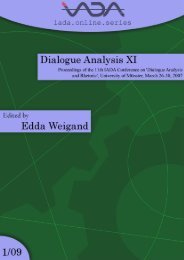Dialogue in and between Different Cultures - International ...
Dialogue in and between Different Cultures - International ...
Dialogue in and between Different Cultures - International ...
Create successful ePaper yourself
Turn your PDF publications into a flip-book with our unique Google optimized e-Paper software.
The Impact of Socio-Cultural Aspects on Language <strong>in</strong> a Chang<strong>in</strong>g World 61<br />
statue Buddha image<br />
statue <strong>in</strong> sleep<strong>in</strong>g/rest<strong>in</strong>g position recl<strong>in</strong><strong>in</strong>g Buddha (image)<br />
offer a gift (<strong>in</strong> ref. to monks) offer a pirikara<br />
Table 4: Associations with Buddhism <strong>in</strong> Sri Lankan English<br />
The da:na or the midday meal offered by laymen to the monks is also referred to<br />
as ‘alms giv<strong>in</strong>g’ or ‘alms giv<strong>in</strong>g ceremony’ <strong>in</strong> Sri Lankan English. Furthermore,<br />
when referr<strong>in</strong>g to Buddhist monks <strong>in</strong> formal S<strong>in</strong>hala, the honorific -himi is added<br />
to the name. Similarly, <strong>in</strong> Sri Lankan English the follow<strong>in</strong>g is used: Ven.<br />
(venerable) + Name + Thero.<br />
In respect to laymen <strong>and</strong> the social distance expressed <strong>in</strong> language, the<br />
S<strong>in</strong>hala tradition of us<strong>in</strong>g honorifics ‘Sir’, ‘Madam’ or ‘Miss’ <strong>in</strong> reference to<br />
teachers <strong>and</strong> k<strong>in</strong>ship terms <strong>in</strong> reference to strangers is also evident <strong>in</strong> SLE.<br />
Although one never hears of strangers be<strong>in</strong>g referred to as aunties <strong>and</strong> uncles,<br />
akkis (“elder sister”, pl.) <strong>and</strong> ayyas (“elder brother”, pl.) among native speakers of<br />
English, the cultural values transferred from S<strong>in</strong>hala are thus evident <strong>in</strong> the Sri<br />
Lankan variety of English.<br />
5. Conclusion<br />
As Disanayaka (1993:128) observes, “Ow<strong>in</strong>g to exigencies of contemporary<br />
economic, political, social <strong>and</strong> technological life, the monk <strong>and</strong> the peasant can no<br />
longer <strong>in</strong>teract the way they did <strong>in</strong> the days of yore.”. However, a society adapts<br />
to new changes while cont<strong>in</strong>u<strong>in</strong>g the traditions h<strong>and</strong>ed down from the past<br />
generations.<br />
In this paper, the chapters (2), (3) <strong>and</strong> (4) presented an analysis of authentic<br />
data from modern S<strong>in</strong>hala that clearly <strong>in</strong>dicates the still existent demarcations <strong>in</strong><br />
the social hierarchy. The first rung <strong>in</strong> the hierarchy is occupied by Buddha,<br />
Buddhist monks <strong>and</strong> the associations with Buddhist temple <strong>and</strong> Buddhism. The<br />
distance <strong>between</strong> the monk <strong>and</strong> the layman, temple <strong>and</strong> the village/house are<br />
clearly <strong>in</strong>dicated <strong>in</strong> the language. Parents, teachers <strong>and</strong> elders occupy<strong>in</strong>g the next<br />
highest position <strong>in</strong> the social hierarchy, comm<strong>and</strong> respect, <strong>and</strong> pronom<strong>in</strong>al<br />
reference is avoided <strong>in</strong> both 2 nd <strong>and</strong> 3 rd person reference. Thus k<strong>in</strong>ship terms <strong>and</strong><br />
honorifics are often used <strong>in</strong>stead of personal pronouns. Further, k<strong>in</strong>ship terms<br />
used <strong>in</strong> reference to strangers reflect a sense of belong<strong>in</strong>g. Heavy use of zero<br />
anaphora <strong>in</strong> place of second <strong>and</strong> third person is also evident, especially when one<br />
is not certa<strong>in</strong> which reference device is to be used. The <strong>in</strong>formal term of 2 nd<br />
person pronoun oyaa is avoided more often than not, other than with peers or<br />
when older address the young.<br />
The data <strong>in</strong>cluded spoken discourse of young adults as well as older<br />
generations. The observations made dur<strong>in</strong>g the analysis are that no significant



